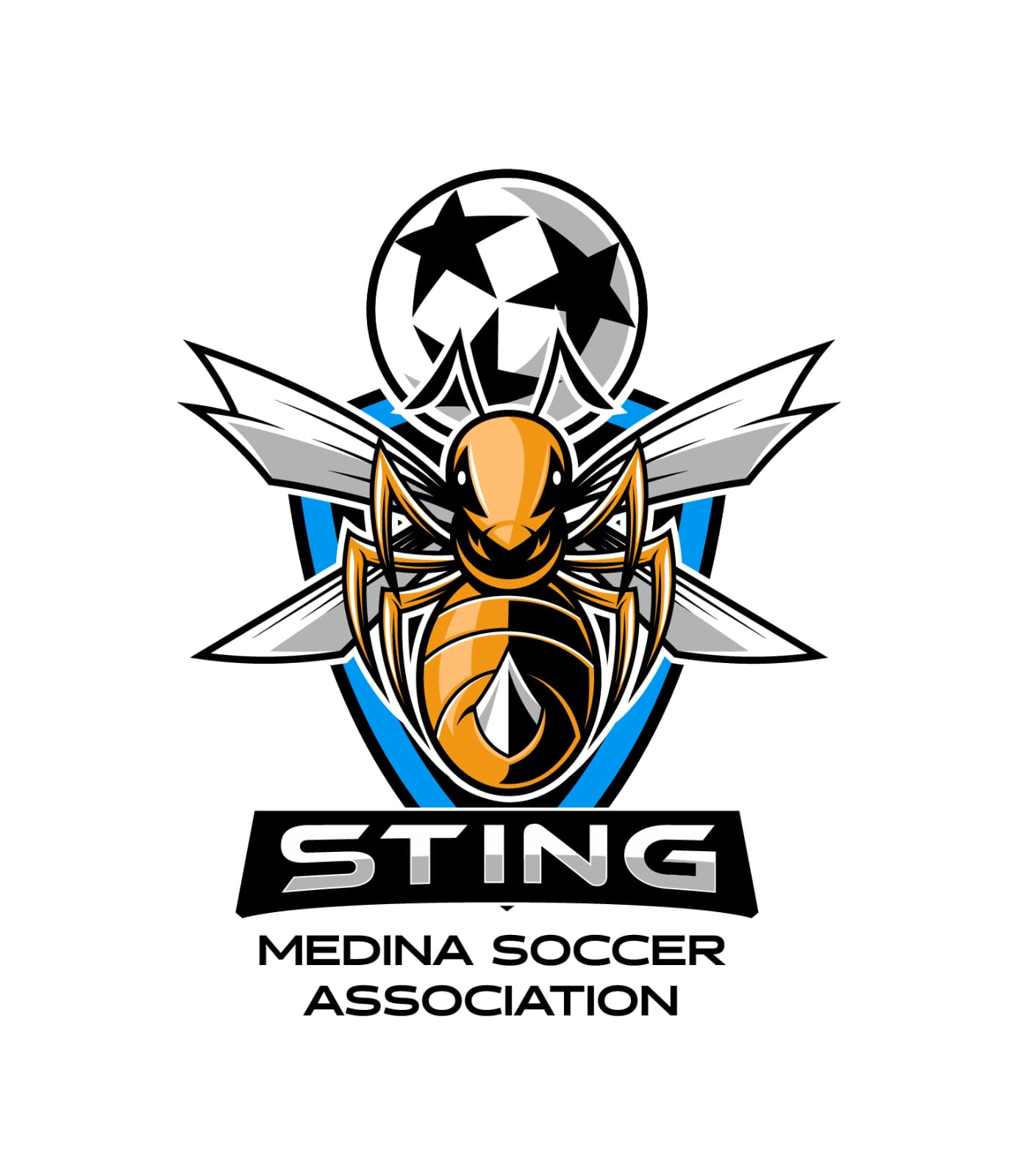Modified for Medina Soccer Association, Inc.
Law 1 – The Field of Play
Dimensions: The field of play must be rectangular. The length of the touchline must be greater than the length of the goal line.
Length: Minimum 50 yards; maximum 65 yards
Width: Minimum 35 yards; maximum 45 yards
Field Markings: Distinctive lines not more than (5) inches wide. The field of play is divided into two halves by a halfway line. The center mark is indicated at the midpoint of the halfway line. A circle with a radius of six (6) yards is marked around it.
Goal Area: 4 yards out from the goal line; 8 yards wide.
Penalty Area: 12 yards out from the goal line; 24 yards wide. A penalty arc with a radius of six (6) yards from the penalty mark is drawn outside the penalty area.
Penalty Mark: 10 yards out from, and centered on, the goal line.
Flag Posts: Conform to FIFA Laws of the Game, if equipment is available.
Corner Arc: Conform to the FIFA Laws of the Game.
Build-Out Line: Two lines are drawn, parallel to and of the same length as, the goal lines such that the field is divided lengthwise into three equal sections. NOTE: The build-out line is used to promote playing the ball out of the back in an unpressured setting. When the goalkeeper has the ball, either during play or from a goal kick, the opposing team must move behind the build-out line. At any time, the goalkeeper may pass, throw, or roll the ball to a teammate, but the goalkeeper does so accepting the positioning of the opponents and the consequences of how play resumes. Punts or drop-kicks are not allowed as this would defeat the purpose of the build-out line and reduces the opportunity to play out of the defending third in an unpressured setting (with this said, we would like to transition in allowing punting during the second half of the season to help U10 transition easily into U12). After the ball is put into play, the opposing team can then cross the build-out line and play resumes as normal.
Goals: Goals must be placed on the center of each goal line. They consist of two upright posts equidistant from the corners and joined at the top by a horizontal crossbar. The recommended distance between the posts is twelve (12) feet and the distance from the lower edge of the crossbar to the ground is six (6) feet.
Safety: Goals must be anchored securely to the ground. Portable goals may only be used if they satisfy this requirement.
Law 2 – The Ball
The ball shall be size four (4) and conform to FIFA standards.
Law 3 – The Number of Players
A match is played by two teams, each consisting of not more than eight (8) players, one of whom is the designated goalkeeper. We strongly recommend 7v7. However, if all players are present, please play 8v8. An official match may not start or continue if either team consists of fewer than five players.
Substitutions: At any stoppage of play and unlimited at the discretion of the referee. If a player with a suspected head injury leaves the field of play for additional evaluation, a substitution may be made at that time.
Playing time: Each player SHALL play a minimum of 50% of the total playing time. It is the coach’s responsibility to enforce this rule.
Law 4 – The Players' Equipment
Conform to the FIFA Laws of the Game. Non-uniform clothing that matches the uniform color is allowed based on weather conditions. Uniforms must distinguish teams. Shin Guards are MANDATORY for both practices and games and must be covered entirely by socks. If needed, teams can be distinguished by scrimmage vests.
Safety: A player must not use equipment or wear anything that is dangerous to himself or another player. Jewelry may not be worn, except for a medical alert bracelet.
Law 5 – The Referee
Registered referee with a minimum U. S. Soccer Grassroots Certification (formerly Grades 9, 8, & 7) or parent/coach or assistant coach.
Law 6 – The Other Match Officials
Registered assistant referees, if available. If registered assistant referees are not assigned, it is permissible to use volunteer line officials (preferably parents) to signal ball out of play. Volunteer officials shall not call offside infractions.
Law 7 – The Duration of the Match
Conform to the FIFA Laws of the Game, except the match shall be divided into two (2) equal halves of twenty (20) minutes. There shall be a half-time interval of up to five (5) minutes. No time shall be added at the end of either half. NOTE: During conditions of extreme heat and humidity, a two-minute water break halfway through each half is acceptable if both coaches agree or if the break is prescribed by the local competition authority. Such water breaks shall create two 10-minute quarters in each half. No overtime period shall be added. In other words, a tie score at the end of a game will NOT result in a penalty shootout to determine the match winner.
Law 8 – The Start and Restart of Play
Conform to the FIFA Laws of the Game, with the exception that the defending team is at least six (6) yards from the ball until it is in play.
Law 9 – The Ball In and Out of Play
Conform to the FIFA Laws of the Game.
Law 10 – The Method of Scoring
Conform to the FIFA Laws of the Game. In the event of a tie game (see Note on Law 7), a penalty shootout shall take place. 5 different players from each team shall kick, starting with the home team, and the team with the higher score shall be the winner. In the event of a tie after the 5 have kicked, different players shall kick again in the same order until one side scores a goal and the other does not.
Law 11 – Offside
Conform to the FIFA Laws of the Game, with the exception that the build-out line also serves as the offside line. Attacking players cannot be penalized for an offside offense between the halfway line and the defending team's build-out line. NOTE: An attacking player must be between the build-out line and the opponent’s goal line to be in an offside position. By using the build-out line as the offside line, it’s far less likely that passes over the top will be made and more space is created for movement off the ball for the second and third attackers.
Law 12 – Fouls and Misconduct
Conform to the FIFA Laws of the Game, with the exception that an indirect free kick is awarded to the opposing team at the spot of the offense if a goalkeeper punts or drop-kicks the ball. If the punt occurs within the goal area, the indirect free kick should be taken on the goal area line parallel to the goal line at the nearest point to where the infringement occurred.
When a player slide tackles or deliberately heads the ball in a game, an indirect free kick shall be awarded to the opposing team from the spot of the offense. If the slide tackle or deliberate header occurs within the infringing team's goal area, the indirect free kick should be taken on the goal area line parallel to the goal line at the point nearest to where the infringement occurred.
Law 13 – Free Kicks
Conform to the FIFA Laws of the Game, with the exception that all opponents are to be at least six (6) yards from the ball until it is kicked.
Law 14 – The Penalty Kick
Conform to the FIFA Laws of the Game, with the exception that the penalty mark is ten (10) yards from the goal line.
Law 15 – The Throw-In
Conform to the FIFA Laws of the Game.
Law 16 – The Goal Kick
Conform to the FIFA Laws of the Game, with the exception that opposing players must retreat behind the build out line until the ball is in play. The team taking the goal kick may choose to restart play before the opponents have retreated behind the build-out line. The ball is in play when it is kicked directly out of the penalty area.
Law 17 – The Corner Kick
Conform to the FIFA Laws of the Game, with the exception that opponents remain at least six (6) yards from the ball until it is kicked.




